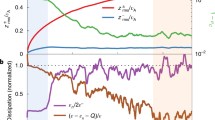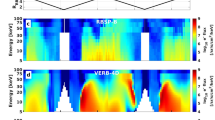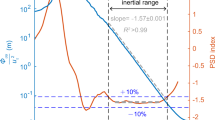Abstract
IN recent communications1,2 and an earlier letter3 various workers have shown that electrodynamic drift (that is, magnetohydrodynamic motion of the magnetic field lines) in the F2 layer would give rise to a phenomenon similar to the observed Appleton anomaly. However1,2, the required drift speeds are much smaller than, the 20 m/sec or more predicted by dynamo theory4,5.
This is a preview of subscription content, access via your institution
Access options
Subscribe to this journal
Receive 51 print issues and online access
$199.00 per year
only $3.90 per issue
Buy this article
- Purchase on Springer Link
- Instant access to full article PDF
Prices may be subject to local taxes which are calculated during checkout
Similar content being viewed by others
References
Bramley, E. N., and Peart, M., Nature, 206, 1245 (1965).
Moffett, R. J., and Hanson, W. B., Nature, 206, 705 (1965).
Kendall, P. C., and Windle, D. W., Nature, 203, 287 (1964).
Maeda, H., J. Geomag. Geoelect., Kyoto, 7, 121 (1955).
DeWitt, R. N., and Akasofu, S.-I., Planet. Space Sci., 12, 1147 (1964).
Goldberg, R. A., Kendall, P. C., and Schmerling, E. R., J. Geophys. Res., 69, 417 (1964).
Goldberg, R. A., J. Geophys. Res., 70, 655 (1965).
Baxter, R. G., and Kendall, P. C., J. Atmos. Terr. Phys., 27, 129 (1964).
Baxter, R. G., J. Atmos. Terr. Phys., 26, 711 (1964).
Baxter, R. G., Kendall, P. C., and Windle, D. W., J. Atmos. Terr. Phys. (in the press).
Hirono, M., and Kitamura, T., J. Geomag. Geoelect., Kyoto, 8, 9 (1956).
Dougherty, J. P., J. Atmos. Terr. Phys., 20, 167 (1961).
Kohl, H., Proc. Intern. Conf. Ionos. (Inst. Phys. and Phys. Soc. Lond.), 198 (1963).
Kendall, P. C., and Windle, D. W., J. Atmos. Terr. Phys. (in the press).
King, J. W., and Kohl, H., Nature, 206, 699 (1965).
Chapman, S., Proc. Phys. Soc., 43, 26 (1931).
Ratcliffe, J. A., Schmerling, E. R., Setty, C. S., and Thomas, J. O., Phil. Trans. Roy. Soc., A, 248, 621 (1956).
Ferraro, V. C. A., Terr. Mag., 50, 215 (1945).
Kendall, P. C., J. Atmos. Terr. Phys., 24, 805 (1962).
Martyn, D. F., Proc. Roy. Soc., A, 189, 241 (1947).
Norton, R. B., and VanZandt, T. E., J. Atmos. Terr. Phys., 26, 1047 (1964).
Rishbeth, H., J. Atmos. Terr. Phys., 26, 657 (1964).
Dougherty, J. P., J. Geophys. Res., 68, 2383 (1963).
Gliddon, J. E. C., Plan. Space Sci.(in the press).
Author information
Authors and Affiliations
Rights and permissions
About this article
Cite this article
KENDALL, P., WINDLE, D. The Appleton Anomaly. Nature 207, 964–965 (1965). https://doi.org/10.1038/207964a0
Issue Date:
DOI: https://doi.org/10.1038/207964a0
This article is cited by
Comments
By submitting a comment you agree to abide by our Terms and Community Guidelines. If you find something abusive or that does not comply with our terms or guidelines please flag it as inappropriate.



